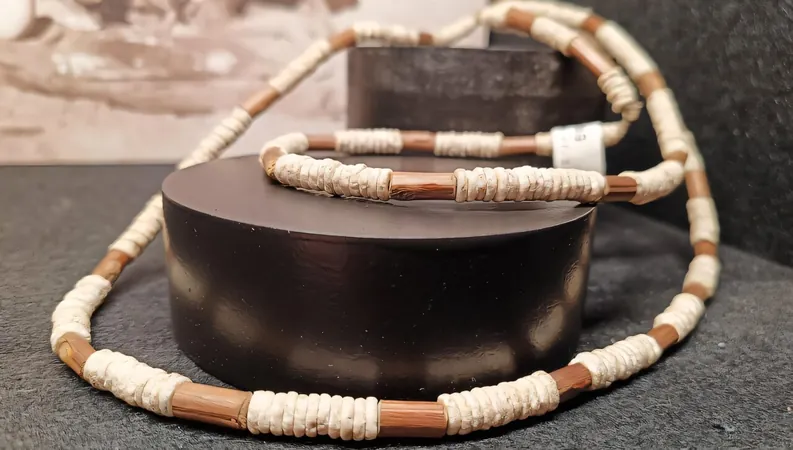
Unearthing Ancient Connections: Strontium Isotopes Reveal Surprising Trade Routes of Ostrich Eggshell Beads in Southern Africa
2024-11-11
Author: Yu
Introduction
A groundbreaking study led by renowned archaeologist Prof. Peter Mitchell has unveiled the intricate exchange networks of ostrich eggshell (OES) beads across southeast southern Africa during the Pleistocene and Holocene epochs. This research, published in the journal Azania: Archaeological Research in Africa, challenges long-held beliefs about the origins and trading routes of these unique artifacts, suggesting a far more complex interaction among prehistoric hunter-gatherer societies than previously understood.
Hunter-Gatherer Communities and OES Beads
Prof. Mitchell and his team focused their analysis on hunter-gatherer communities in the Lesotho highlands, revealing that these societies were capable of obtaining OES beads from distances exceeding hundreds of kilometers. This finding disputes earlier assumptions that OES beads, thought to have been introduced from East Africa, experienced a drastic decline during a so-called period of disappearance around 33,000 to 19,000 years ago.
Cultural Significance of Ostrich Eggshell Beads
Ostrich eggshell beads, which have been discovered in archaeological contexts dating back more than 50,000 years, have long been valued as one of the most prevalent forms of jewelry in pre-colonial southern Africa. Their durability and abundance make them a more accessible and functional option compared to other materials, including shells from estuarine or marine sources.
Deeply woven into the fabric of the spiritual and social lives of hunter-gatherers, ostriches held immense significance. Various communities attributed the creation of humans and vital knowledge, such as fire, to these majestic birds. The ostrich not only symbolized healing and resurrection but was also believed to lend its inherent power to artifacts made from its remains. Beads crafted from ostrich eggshell were thought to possess healing properties, making them essential in community healing rituals and trance ceremonies led by shamans.
The hxaro Exchange System
The study highlights the cultural weight attached to OES beads, particularly within the hxaro exchange system of the Ju/hoãsi (!Kung) people. This sophisticated network involved deliberate gifting and resource sharing, maintaining connections across vast distances. The term 'hxaro' itself is derived from the tradition of exchanging ostrich eggshell beadwork, further emphasizing its importance in societal relationships, including marriage arrangements.
Challenging Previous Research
Previous research suggested that the variability in bead sizes indicated a clear introduction of OES-making to southern Africa from East Africa, culminating in a breakdown of these networks due to environmental factors like flooding and drought. However, Prof. Mitchell’s team critiques this hypothesis, arguing that bead sizes correlate more closely with their intended use than with distinct geographic communities. They highlight overlooked factors, such as excavation methods and conservation challenges, that may have misrepresented the distribution of OES beads in archaeological records.
Investigation Findings and Trade Routes
Intrigued by the unexpected discovery of OES beads in Lesotho—an area devoid of ostriches—Prof. Mitchell's investigation reveals a broader narrative of trade and interaction across the region. The research encompassed a rigorous analysis of two archaeological sites in the Lesotho highlands: Melikane and Sehonghong. By employing strontium isotope analysis, the researchers traced the geographic origins of 27 OES beads and found that all were sourced from over 109 to 164 kilometers away, with three beads traveling as far as 325 kilometers. This strong evidence suggests that OES beads were actively circulated through regional networks spanning hundreds of kilometers—a striking contrast to earlier claims of much longer trade routes.
Implications for Future Research
The implications of this study resonate not just within the field of archaeology but also shed light on the complex social dynamics and exchange practices of ancient communities in southern Africa. As Prof. Mitchell and his colleagues plan to broaden their research with a larger sample size and diverse geographical scope, the narrative of these ancient trade routes continues to unfold, revealing a rich tapestry of cultural exchange that shaped the prehistoric landscape of southern Africa.
Conclusion
Stay tuned! The secrets of the past are waiting to be uncovered!

 Brasil (PT)
Brasil (PT)
 Canada (EN)
Canada (EN)
 Chile (ES)
Chile (ES)
 España (ES)
España (ES)
 France (FR)
France (FR)
 Hong Kong (EN)
Hong Kong (EN)
 Italia (IT)
Italia (IT)
 日本 (JA)
日本 (JA)
 Magyarország (HU)
Magyarország (HU)
 Norge (NO)
Norge (NO)
 Polska (PL)
Polska (PL)
 Schweiz (DE)
Schweiz (DE)
 Singapore (EN)
Singapore (EN)
 Sverige (SV)
Sverige (SV)
 Suomi (FI)
Suomi (FI)
 Türkiye (TR)
Türkiye (TR)